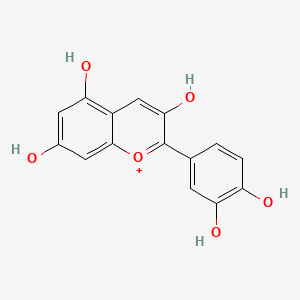| MeSH term | MeSH ID | Detail |
|---|---|---|
| Colonic Neoplasms | D003110 | 161 associated lipids |
| Edema | D004487 | 152 associated lipids |
| Glioma | D005910 | 112 associated lipids |
| Tooth Discoloration | D014075 | 7 associated lipids |
| Psoriasis | D011565 | 47 associated lipids |
| Wound Infection | D014946 | 12 associated lipids |
| Nerve Degeneration | D009410 | 53 associated lipids |
Cyanidin
Cyanidin is a lipid of Polyketides (PK) class. Cyanidin is associated with abnormalities such as Consumption-archaic term for TB, furuncle, Obesity, Cardiovascular Diseases and Endothelial dysfunction. The involved functions are known as anthocyanin biosynthetic process, Regulation, flavonoid biosynthetic process, Anabolism and anthocyanin metabolic process. Cyanidin often locates in Body tissue, integral to membrane, Autonomic nervous system, Blood and Tissue membrane. The associated genes with Cyanidin are anthocyanidin synthase, SLC2A8 gene, EPB41L2 gene, NKS1 gene and GLUCOSIDASE. The related lipids are Butanols. The related experimental models are Knock-out.
Cross Reference
Introduction
To understand associated biological information of Cyanidin, we collected biological information of abnormalities, associated pathways, cellular/molecular locations, biological functions, related genes/proteins, lipids and common seen animal/experimental models with organized paragraphs from literatures.
What diseases are associated with Cyanidin?
Cyanidin is suspected in Obesity, Chronic Disease, Diabetes Mellitus, Non-Insulin-Dependent, Cardiovascular Diseases, Heart Diseases, Inflammatory disorder and other diseases in descending order of the highest number of associated sentences.
Related references are mostly published in these journals:
| Disease | Cross reference | Weighted score | Related literature |
|---|
Possible diseases from mapped MeSH terms on references
We collected disease MeSH terms mapped to the references associated with Cyanidin
PubChem Associated disorders and diseases
What pathways are associated with Cyanidin
There are no associated biomedical information in the current reference collection.
PubChem Biomolecular Interactions and Pathways
Link to PubChem Biomolecular Interactions and PathwaysWhat cellular locations are associated with Cyanidin?
Visualization in cellular structure
Associated locations are in red color. Not associated locations are in black.
Related references are published most in these journals:
| Location | Cross reference | Weighted score | Related literatures |
|---|
What functions are associated with Cyanidin?
Related references are published most in these journals:
| Function | Cross reference | Weighted score | Related literatures |
|---|
What lipids are associated with Cyanidin?
Related references are published most in these journals:
| Lipid concept | Cross reference | Weighted score | Related literatures |
|---|
What genes are associated with Cyanidin?
Related references are published most in these journals:
| Gene | Cross reference | Weighted score | Related literatures |
|---|
What common seen animal models are associated with Cyanidin?
Knock-out
Knock-out are used in the study 'MATE2 mediates vacuolar sequestration of flavonoid glycosides and glycoside malonates in Medicago truncatula.' (Zhao J et al., 2011) and Knock-out are used in the study 'How can research on plants contribute to promoting human health?' (Martin C et al., 2011).
Disease model
Disease model are used in the study 'How can research on plants contribute to promoting human health?' (Martin C et al., 2011).
Animal Disease Models
Animal Disease Models are used in the study 'How can research on plants contribute to promoting human health?' (Martin C et al., 2011).
Related references are published most in these journals:
| Model | Cross reference | Weighted score | Related literatures |
|---|
NCBI Entrez Crosslinks
All references with Cyanidin
Download all related citations| Authors | Title | Published | Journal | PubMed Link |
|---|---|---|---|---|
| Kadigamuwa CC et al. | 2, 2'- and 4, 4'-Cyanines are transporter-independent in vitro dopaminergic toxins with the specificity and mechanism of toxicity similar to MPPâº. | 2015 | J. Neurochem. | pmid:26094622 |
| Ahn JH et al. | De Novo Transcriptome Analysis to Identify Anthocyanin Biosynthesis Genes Responsible for Tissue-Specific Pigmentation in Zoysiagrass (Zoysia japonica Steud.). | 2015 | PLoS ONE | pmid:25905914 |
| Kim RJ et al. | Antioxidant's cytoprotective effects on rotator cuff tenofibroblasts exposed to aminoamide local anesthetics. | 2015 | J. Orthop. Res. | pmid:25639557 |
| Khandelwal N and Abraham SK | Protective effects of common anthocyanidins against genotoxic damage induced by chemotherapeutic drugs in mice. | 2014 | Planta Med. | pmid:25184891 |
| Thummayot S et al. | Neuroprotective effect of purple rice extract and its constituent against amyloid beta-induced neuronal cell death in SK-N-SH cells. | 2014 | Neurotoxicology | pmid:25451968 |
| Scheit K and Bauer G | Synergistic effects between catalase inhibitors and modulators of nitric oxide metabolism on tumor cell apoptosis. | 2014 | Anticancer Res. | pmid:25275027 |
| Sui X and Zhou W | Monte Carlo modelling of non-isothermal degradation of two cyanidin-based anthocyanins in aqueous system at high temperatures and its impact on antioxidant capacities. | 2014 | Food Chem | pmid:24262567 |
| Austin HR et al. | Regulation of late cornified envelope genes relevant to psoriasis risk by plant-derived cyanidin. | 2014 | Biochem. Biophys. Res. Commun. | pmid:24393842 |
| Chen R et al. | Effects of the vegetable polyphenols epigallocatechin-3-gallate, luteolin, apigenin, myricetin, quercetin, and cyanidin in primary cultures of human retinal pigment epithelial cells. | 2014 | Mol. Vis. | pmid:24623967 |
| Bijak M et al. | Thrombin inhibitory activity of some polyphenolic compounds. | 2014 | Med Chem Res | pmid:24610996 |
